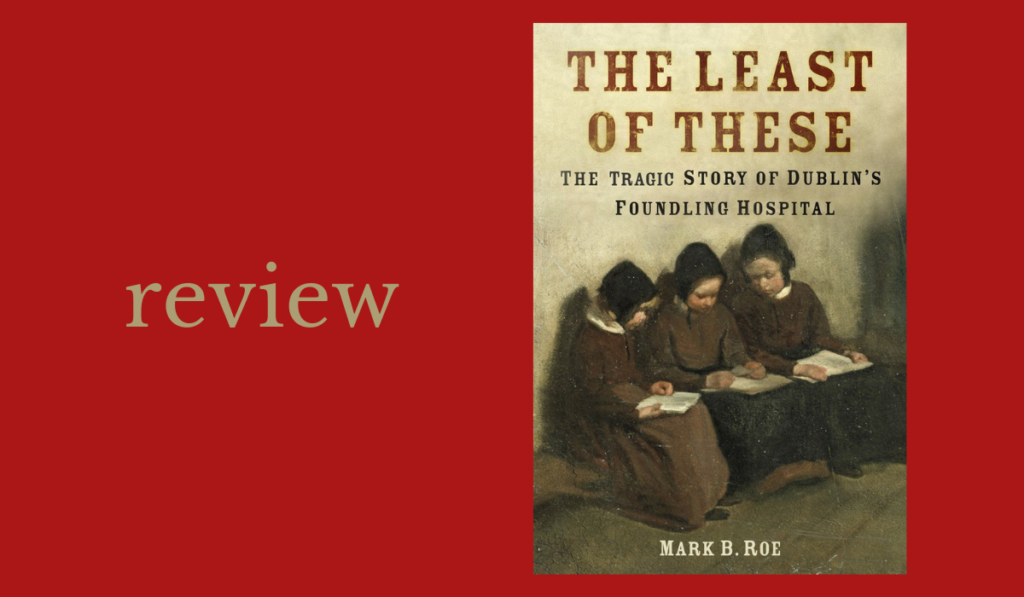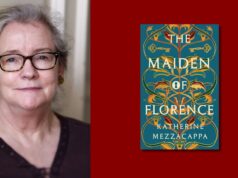
The Least of These: The Tragic Story of Dublin’s Foundling Hospital|Mark B. Roe|The History Press|ISBN: 978 0 7509 9876 5|£16.49
“The appalling death rates had other causes, apart from the terrible living conditions at the Hospital…But a significant cause was ‘the bottle’, which was made up of opium, usually in the form of laudanum.“
—John Kirkaldy on a first-rate history of the horrifying practices of Dublin’s Foundling Hospital
by John Kirkaldy
This is a very depressing but enthralling read. The Least of These is indeed ‘the tragic story of Dublin’s Foundling Hospital’. It was founded in 1703 during the Penal Laws and was abolished in 1830.
‘Its mission to take in the children of poor Catholics and raise them as Protestants, loyal to king and empire. This was an institution where every infant was tattooed with an identification number, where thousands of children were fed opium and, where as with many foundling hospitals, the death toll was vast.’
First-rate history
Mark B. Roe is to be congratulated on a book of first-rate history: clearly written, well organised and based, wherever possible, on primary sources, after extensive research.
Even at the distance of three centuries, this is a shocking indictment of those responsible.
Between 1790 and 1796, some 5216 infants were sent there, of whom 5215 died, a statistic that would have satisfied a Nazi concentration camp. Things improved slightly between 1796 and 1826, 51,150 infants were admitted, of whom 41,524 died. (Similar figures can be seen at the Foundling Hospital in Cork.)
In 1757, Reverent Hill, the Chaplain to the hospital for twenty years, told a Parliamentary enquiry that burials took place usually three times a week, with him standing a long way off to avoid contamination. Twelve bodies were often buried at one session and the burial ground was ‘so full of dead bodies that in digging a grave, other bodies are frequently thrown up’.
Scandal and controversy
Descriptions of the premises include massive overcrowding, minimal supervision, terrible food, filthy premises, very poor sleeping accommodation and a dreadful level of hygiene.
When John Bishop, a foundling child, for example, complained that his portion of meat was full of maggots, he was given twenty lashes on his naked back with the cat-o’nine-tails.
Scandal and controversy dogged the institution from the start. In 1734, Charles Sprainger, the Treasurer, committed suicide, ‘thro’ a consciousness of a deficiency in his accounts’.
In 1759, the Governors were offering a reward to anyone who could apprehend Joseph Purcell, who had disappeared with £1200 of the Hospital’s money, the equivalent of 30 years of his salary.
Major criticisms were made at the time into the standard of medical supervision by doctors in charge, such as Philip Woodroffe and William Harvey.

A few bright spots
There were a few bright spots in the Hospital’s management. Lady Arbella Denny worked tirelessly behind the scenes, as a semi-official lady governess, and was a positive force for over twenty years.
She pioneered some worthwhile reforms and was adept at fund raising (helped by some good social connections; her nephew, the Earl of Shelburne was for a short while British Prime Minister).
His forcefulness of character can be judged by the fact that when angered by her brother-in-law, Sir Thomas Denny; she practised with a pistol and became an accomplished shot.
She later took him to a secluded spot and demonstrated her expertise; threatening to shoot him if there were any more problems. The annoyance ceased.
John Creighton, appointed as a resident surgeon at 29, was a rare example of successful medical expertise in a dismal record.
Appalling death rates
The appalling death rates had other causes, apart from the terrible living conditions at the Hospital.
Most of the babies had been born in dire poverty (often to domestic servants). Some had to endure a long journey from the country to Dublin.
But a significant cause was ‘the bottle’, which was made up of opium, usually in the form of laudanum.
It was the one medicine that was always in plentiful supply, as the children ‘were easy after taking it for an hour or two’. Roe accurately comments: ‘clearly it was given to silence the desperate cries of starving babies. However, in a new born infant who was already starving, the effect must have been catastrophic, for it would reduce the desire to feed and hasten the downward spiral to death.’
A contemporary commented that ‘the Bottle’ was given to all ‘except to children in a dying state’. By that time the children were so weakened by starvation, no sedative was needed.
Another traditional remedy was the use of mercury as a medicine, which also had disastrous side effects.
Tattooed and registered
On arrival, the infants were tattooed and registered. If they survived after some days, they were dispatched to live with a country nurse. There they remained, ‘until they were as old as 12 or even older’, depending on spaces at the Hospital.
Most of the nurses were Catholic and it remained a perennial anxiety with officialdom that ‘Papists’ were being created, starting with mothers’ milk!
In 1824, it was decided that ‘all children above the age of four years, and, who are now with Roman Catholic nurses, be transferred to Protestant nurses’. This was very much influenced by the arrival of a new Archbishop of Dublin, William Magee, who was described by a contemporary as being ‘obsessive anti-Catholicism’.
A Spartan regime
On returning to the Hospital after some years (often a heart-breaking process, as family ties had been established), the children faced a Spartan regime, starting for much of the year at 5am. Boys and girls were divided into schools of about 40, ranging over all ages.
It does not come as any surprise to learn that the curriculum was very traditional with a heavy emphasis on the Protestant religion.
In 1829, the British Parliament passed the Catholic Emancipation Act, which made the Hospital something of an anachronism. In 1830, the Hospital was closed and its last recorded former inmate, an elderly lady, died in 1911.
Roe’s achievement is to bring to light a very neglected part of Irish history. As a historian with a medical background, he has achieved a degree of recognition for about 127,000 souls, who otherwise would remain just a dismal statistic.
I would highly recommend this book but it is not a pleasant read.

John Kirkaldy has a PhD in Irish History, worked for many years with the Open University and has been reviewing for Books Ireland since 1980. He has contributed to three Irish history anthologies, a school textbook, and has been involved in a number of Open University History documentary series. Aged 70, two years ago, he went round the world on a much delayed gap year described in his book, I’ve Got a Metal Knee: a 70-Year Old’s Gap Year.












